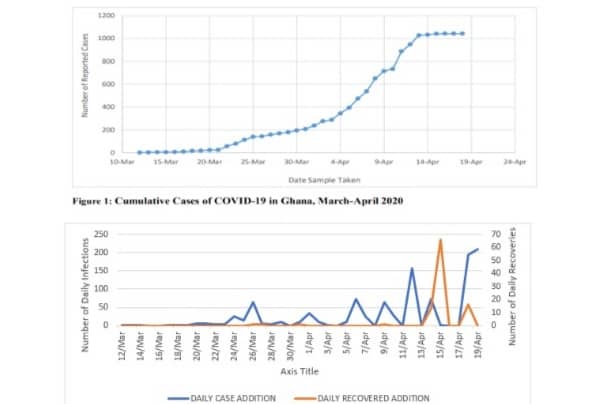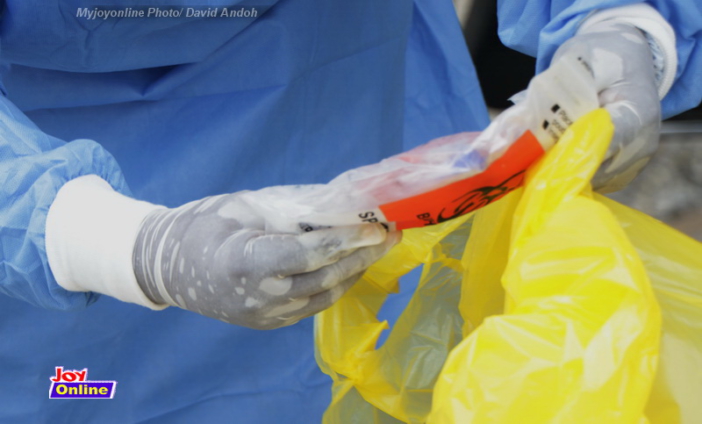Scope
This write-up presents a review of the available numbers on COVID-19 and premised on experiences from other countries makes recommendations on the data required to put forward an aggressive fight against the pandemic. This engagement is necessary as the implications of the pandemic transcend the obvious health ramifications to economic, political, psycho-social and futuristic systems disruptions. The source of data for this exposition is the Worldometer (https://www.worldometers.info/coronavirus/) and Ghana Health Service (https://ghanahealthservice.org/covid19/) websites as at 07:02am on 20th April 2020. This note reviews the univariate and bi-lateral relationship between the following variables: test cases, infection cases, recovery cases, death cases and country specific containment of the pandemic.
- Review
On a global scale relative to Africa and Ghana, the following number of cases (n) and corresponding percentages (%) and correlation coefficients (CC) provide a base to review Ghana’s status and efforts in fighting the pandemic:
Table 1: COVID-19: Cases of Testing, Infections, Recovery and Death
| No. | Variables | Global [n, %, CC] | Africa [n, %, CC] | Ghana [n, %] |
| Infection to test cases | 2,408,343 : 20,638,170 [11.67%; 0.89{0.00}] | 22,922 : 372,164 [6.16%; 0.70{0.00}] | 1042 : 68,591 [1.52%] | |
| Recovery to test cases | 628,757 : 20,638,170 [3.05%; 0.72{0.00}] | 5846 : 372,164 [1.60%; 0.62{0.00}] | 99 : 68,591 [0.14%] | |
| Death to test cases | 165,105 : 20,638,170 [0.80%; 0.77{0.00}] | 1,128 : 372,164 [0.30%; 0.21{0.31}] | 9 : 68,591 [0.01%] | |
| Recovery to infection cases | 628,757: 2,408,343 [26.10%; 0.70{0.00}] | 5846 : 22,922 [25.50%; 0.89{0.00}] | 99 : 1042 [9.50%] | |
| Death to infection cases | 165,105: 2,408,343 [6.86%; 0.92{0.00}] | 1128 : 22,922 [4.92%; 0.78{0.00}] | 9 : 1042 [0.86%] |
The following five considerations are imperatives for any plausible deductions that can be made from the above percentages: individual countries self-report data; data frequency is not consistent within and across countries; time lag between collection of samples for testing and declaration of the outcome of the tests is unknown; dissimilarities within and across countries in the cohort of persons targeted for testing; and variations in the stage of the outbreak of COVID-19 across countries. While the temptation of discussing the biases associated with these issues is upheld, outlining them presents an opportunity to interrogate Ghana’s release of data on COVID-19. The Ghana Health Service (GHS) commendably has provided data on a number of key variables on COVID-19 including number of infections, recovery, death management of cases, response to treatment and health status of infected persons. In addition, the data has been disaggregated based on sex, age and location. Figure 1 as presented on the website of the GHS (https://ghanahealthservice.org/covid19/) shows growth in the number of cases over time. Diligently, GHS cautions against the association of changes in the number of cases with the day of the report in view of the backlog of samples. However, the description on the x-axis “Date sample taken” unravels the problem associated with gaps in frequency of reporting and unknown time lag between collection of samples for testing and declaration of the outcome of the tests. To unmask the effects of a line graph of the total number of COVID-19 cases in Ghana as shown in Figure 1, we present individual daily records of cases, recovery and death in Figure 2. The spikes and gaps in both infection and recovery constrains effort to predict the peak and rate of slowdown of the pandemic in Ghana.

Figure 2: Number of Daily Cases of Infections and Recovery of COVID-19
The key observations from Table 1 are as follows:
- The decision to embrace testing as a critical step in curbing the fight against the pandemic is upheld. At both the global and Africa levels, the cases of infection, recovery and death are observed to significantly correlate with test cases.
- The death to test cases in Africa is the only correlation coefficient that is not statistically significant. This presents a warning signal to Africa countries that are not testing.
- While recovery to infection rates are comparable for the global and Africa cases, the evidence from Ghana is worrying. The proportion of recovery to infection is less than 50% relative to the global and Africa evidence.
- Relative to the other indicators, Africa seems to be catching up on death to infection rates.
- Ghana’s evidence of cases of death attributable to COVID-19 seem comforting. However, it is important to be circumspect as evidence from the United Kingdom suggests under estimation of COVID-19 related deaths.
- Recommendations
The following recommendations are offered to engender a more evidenced-based approach in instituting interventions to curb the spread of the pandemic, increase cases of recovered persons and subsequently halt associated death.
- The National Response Team on COVID-19 should engage with multiple data sources beyond rates of infection and recovery and examine relationships and movements across different variables such as data on mobility of persons (not only travel history) and timing of incidence of infection to inform decision-making in curbing down the pandemic.
- Efforts by GHS to increase testing should be supported to enhance its actualization. In addition to the targeted testing exercise that is currently being rolled out, which is non-random, a representative sample of the population should be tested to help estimate the plateau for COVID-19. Further to this, the testing exercise should be diversified by bringing on board antibody testing. This will help appreciate the proportion of our population that have immune systems capable of fighting the virus.
- The GHS should publish the time-lag between collection of sample and release of results. Though the constraints on resources for testing are well appreciated, the aim of shortening the duration between collection of sample and release of results is to make the interventions being instituted align with the current happenings on the rate of infection.
- The GHS should publish daily rates of recovery of persons as a result of COVID-19 infection. This will engender a prediction of the total number of recoveries should the infection rate of the pandemic subside.
- The Ministry of Information in collaboration with the GHS should develop a protocol, which outlines processes for engaging infected persons in the various facilities and intensify sensitisation of the general public on the procedures for managing COVID-19 cases from home.
- The Ministry of Health should mandate all health facilities to share their anonymized data on death cases in the past year, including the past one month, with the Ghana Statistical Service to facilitate an assessment of possible shifts in the incidence of death in Ghana.
Samuel Kobina Annim
Latest Stories
-
ECG Power Queens support Ho Female Prison
11 minutes -
Don’t appoint a new EC Chair; allow Jean Mensa to work – Prof. Stephen Adei to Mahama
36 minutes -
Bayer Leverkusen’s Jeremie Frimpong arrives in Ghana for visit
59 minutes -
‘It will be disastrous if Mahama removes the Chief Justice’ – Prof. Stephen Adei
1 hour -
Jean Mensa must step down as EC Chair – APC and Movement for Change assert
1 hour -
Akufo-Addo calls on police to refine strategies to avoid prolonged electoral unrest
1 hour -
Only NPP looting brigade unhappy about ORAL – Ablakwa
1 hour -
CSIR-SARI introduces integrated soil fertility management technology to boost maize production
1 hour -
Ghana’s indigenous agribusiness faces challenges impacting economic growth – Dr. Azinu
1 hour -
41-year-old man arrested over illegal power connection
2 hours -
65-year-old man plans to walk over 250-km Kumasi-Accra journey for Mahama’s swearing-in
2 hours -
Woman dies after being set on fire on NYC subway
3 hours -
Elon Musk’s curious fixation with Britain
3 hours -
EBID wins the Africa Sustainability Award
5 hours -
Expansion Drive: Takoradi Technical University increases faculties
9 hours

